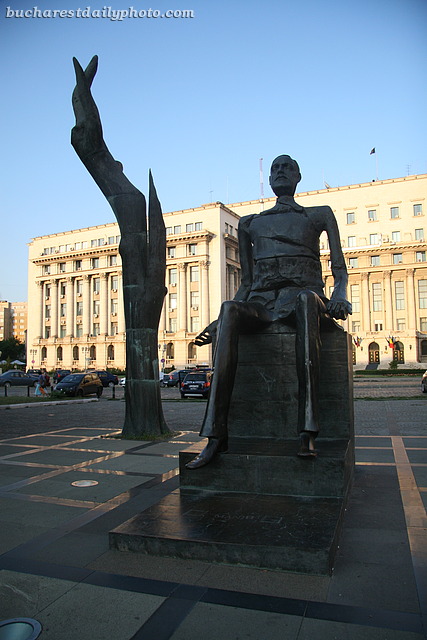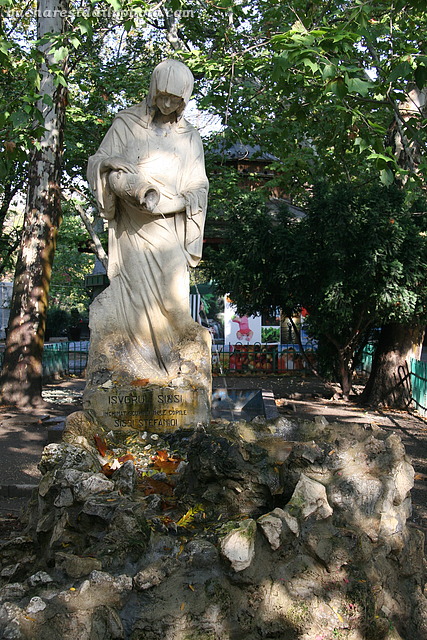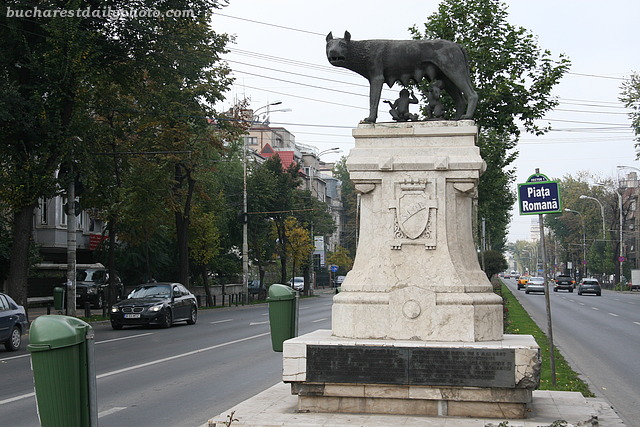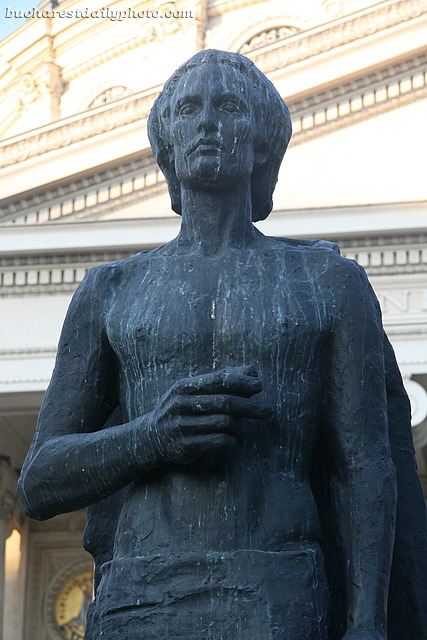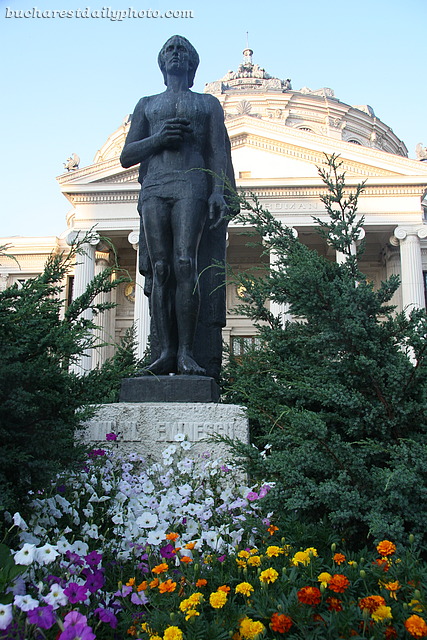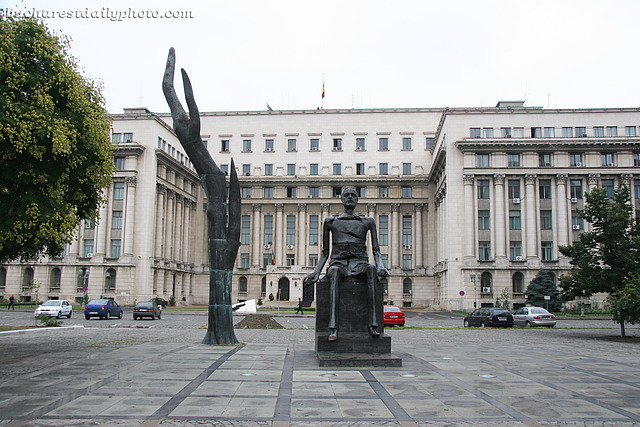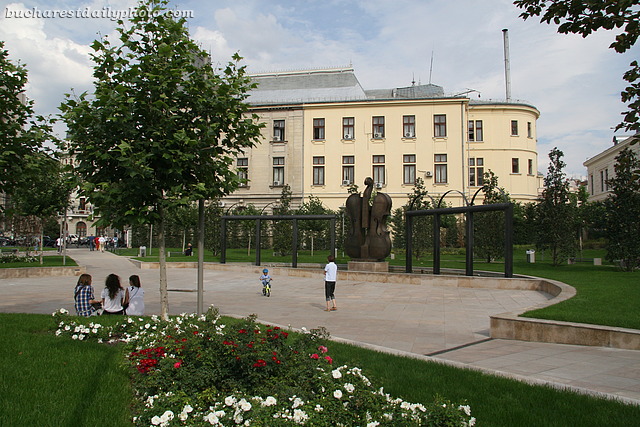Cişmigiu Park is one of my favourite places in Bucharest. In my college days I used to stroll these paths almost every day, hand in hand with my sweetheart, talking about our plans and the world as we saw it through the eyes of two 20 year olds. Back in those days I used to spend a considerable amount of time in Cişmigiu. After I graduated and started to work, I rarely found the time to go to the park. But since starting this blog I’ve been passing through Cişmigiu a lot, in search for subjects to photograph. I always find something worth photographing there, like the black swan or the patriotic benches that I showed to you on previous posts. Cişmigiu has some nice landmarks or points of attraction which I have yet to photograph so I have plenty of reasons to return to the park. Today’s photo shows one of these landmarks, “The Sissi Spring”. This beautiful statue was created by the sculptor Dimitriu Bârlad (1890-1964) and depicts a mother mourning the death of her daughter, pouring water from a pitcher. The engraving reads “Dedicated to my beloved daughter Sissi Stefanidi”.
I guess most of you are familiar with the famous statue of the Capitoline Wolf, the symbol of the founding of Rome. The statue depicts the twin brothers Romulus and Remus suckling on a she wolf. The original sits in Museo Nuovo in the Palazzo dei Conservatori on Rome’s Campidoglio. There is still a debate going on regarding its attribution and dating. I can’t help the debate regarding the origin of Rome’s Capitoline Wolf, but I think I can tell you where Bucharest’s She Wolf (Lupoaica in Romanian) came from. This statue was a gift from the city of Rome given to Bucharest in 1906 with the occasion of the “General Exhibition of Romania” (also named “Jubilee National Exhibition”) which marked three events: 40 years since the crowning of King Carol I as the ruler of Romania, 25 years since the Proclamation of Independence by the Romanian Kingdom, and 1,800 years since the emperor Trajan’s colonization of Dacia (current day Romania) in 106. The exhibition, modelled after the World Fair that took place in Paris in 1900, was located in Carol I Park and was intended to show the progresses made by Romania in different areas: politics, culture etc. The statue was first displayed at the Roman Arenas in Carol Park. After this short moment of glory, the poor She Wolf was moved from one place to another, all around Bucharest. From the Roman Arenas the statue was taken to St. George Square (Piaţa Sfântul Gheorghe in Romanian) only to be relocated again on the Metropolitan Church Hill in 1931. While there, she was the reason of a little controversy because some inventive mind came up with the idea that the She Wolf has its back to the altar, being totally impolite in that regard. So in 1965 it was moved again to a little park in the Dorobanţi Square. Finally, in 1997 it was brought to its current location, a corner of the Roman Square (Piaţa Romană in Romanian) in downtown Bucharest. But the story doesn’t end here. To top it all off, the mayor of Bucharest announced a few months ago – among some protests – that he is thinking of moving it again by the end of the year, this time close to its original location in St. George Square. But so far the She Wolf still sits in the Roman Square, watching patiently the nightmarish traffic of Bucharest and probably staring at the huge Coca Cola bottle that’s been dominating the square for the last two years.
Mihai Eminescu (January 15, 1850 – June 15, 1889) was a late Romantic poet which is considered to be the most influential Romanian poet and has been crowned by many as “Romania’s national poet”. Studying his poems is required in Romanian language schools and I remember getting one of this poems as subject at my Baccalaureate exam (the high school exit exam). His portrait can be seen everywhere in Romania. He is on the 500 lei bill (leu, plural lei, is the Romanian currency) but since that is the highest denomination Romanian bill, the equivalent of 115 euros or $170 you don’t get to see many of those. Many schools and libraries in Romania are named after him and you can see statues of Eminescu everywhere in Romania – like the one in today’s photo, located in front of the Romanian Athenaeum. A few years ago there was a huge scandal when a few young Romanian writers wrote about their idea of Eminescu and against the official idolized image of the poet.
Today is another crazy day when I’ll be traveling for 20 hours and I won’t have time for a lengthy post. But I didn’t want to miss the day so I decided to post a photo on a subject that I’ve already written about, just shot from another angle. This was one of my first posts so some of you might have missed it. Today’s subject is the Iuliu Maniu statue in Revolution Square and you’ll find the initial photo here.
Roughtly about two months ago I saw work being done on the southeast corner of the University Square, the one with Colţea Hospital and the Ministry of Agriculture building. Knowing that the little park was renovated only about two years ago I asked myself, as I’m sure many of my fellow citizens did, “Why are they renovating this corner again?”. Turns out they were repairing the fountain and installing a giant bronze violin, a work of artist Ioan Bolborea made after a project by the Italian artist Domenica Regazzoni. Domenica Regazzoni has a series of violins, the one installed in Univeristy Square being “The broken violin”. Sculpture aside, I really like this little corner of peace right in the heart of such a chaotic city as Bucharest. It’s a great place to sit on a bench and watch the world go by.
